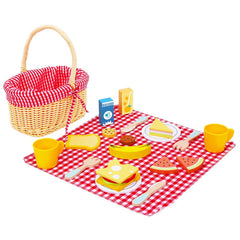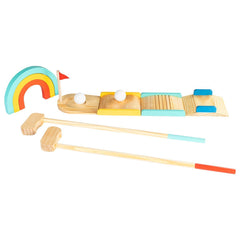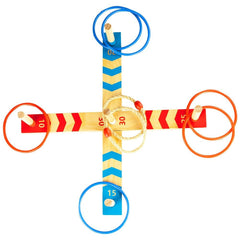Toy kitchens are carefully crafted spaces where learning comes to life. They do this by offering interesting activities, such as pretend cooking and organising shelves. And these activities aid kids in understanding real-life roles through play. Additionally, play kitchen sets also ensure better life skills like decision-making and communication.
We know how crucial this kind of learning is. And that’s why we are here with our wooden toy kitchens, which ignite imagination and promote hands-on discovery.
Let’s take a closer look at how a toy kitchen can become a truly meaningful part of your child’s everyday play.
Benefits of a Wooden Toy Kitchen
Builds Imagination and Roleplay
When children play with a toy kitchen, they enter a different world. In this world, they think of cooking meals, setting the table, and even serving food to their family or stuffed toys. And this activity builds creativity and helps kids understand the world around them.
It also lets kids take on various roles, ranging from chefs to a parent or even a restaurant owner. And these diverse and distinct roles help children understand different professions.
Improves Communication Skills
A toy kitchen makes an apt setting for conversations to shuffle. So, whether kids play solo or with friends, they are bound to practise speaking. And this activity ensures that they learn how to take turns, ask questions, and share ideas.
You may hear them saying things like, “Would you like tea?” or “Let me cook some pasta.” If you do so, understand how these simple lines help children build their vocabulary. And with better vocabulary, they tend to express themselves better.
Promotes Physical Development
It takes swift movements to open cupboards, turn knobs, stir with a spoon, or place food on a plate. And movement develops fine motor skills. Consequently, children learn how to move their fingers and hands in better ways.
In the larger picture, kids also use their whole body to reach for items or move around the play kitchen. And this kind of movement builds balance and coordination.
Encourages Social Skills and Teamwork
When children play with others, they learn to work as a team. Hence, they take turns being the cook or the guest. And these chains of people, they learn to wait, share, and listen to others’ ideas.
This builds strong social skills. Children become more confident in group settings and learn how to solve small problems together. These early-on lessons leave lifelong benefits.
Sparks Interest in Healthy Eating
Toy kitchens often come with play food that children love to serve. And this activity introduces them to the idea of healthy eating. Further, questions like “What is this vegetable?” or “Can I make soup with this?” open up conversations about food and nutrition. And this process pushes kids to be curious about what they eat at home.
Teaches Life Skills
Children watch adults in the kitchen every day. And if they want to copy adults, then a toy kitchen gives them the perfect chance. But in the process of copying adults in the kitchen, kids learn simple skills like organisation, meal planning, or cleaning up after cooking.
And they also learn how to be responsible. Because putting things back where they belong or remembering what food goes in which cupboard helps them build routines.
Encourages Independent Play
Occasionally, it is important to make children play without adult intervention. And for this, a toy kitchen is the perfect go-to option because it keeps children engaged for long periods.
During this time, children become more confident because they begin to trust their choices. They also tend to enjoy doing various things without help. This also benefits parents by providing them with some quiet time for themselves.
Now that we know how beneficial toy kitchens are, let us understand how to choose the right one.
How to Choose the Right Toy Kitchen
Selecting the perfect toy kitchen is a tedious task, and we know that it looks tough. Hence, Barnshenn is here to break it down for you.
Start by thinking about your space and deciding if you want a compact or a detailed kitchen set. Remember to pick one that fits perfectly in your home without making it congested. Materials hold value as well. So, look for strong and eco-friendly wood that can handle everyday play.
The next thing you need to consider is your child’s age. If you have a younger child, go for basic designs with large knobs and shelves. But if you have an older child, go for more detailed features like pretend ovens, taps, and cupboards. In either scenario, check for age-appropriate heights and safety features like smooth edges and sturdy construction.
Furthermore, think about how interactive the kitchen is. Check whether it has turning knobs, storage shelves, and a pretend sink. These small details and features provide the necessary spice for toddlers.
Why Do Parents Love Toy Kitchens Too?
Toy kitchens aren’t just a hit with kids—they’re a favourite among parents too. And one of the main reasons for this to happen is that they keep little ones busy for hours. They also teach kids how to focus, plan, and express their ideas through imaginative play.
Additionally, they let children take on new roles like chef, waiter, or shopper, all from the comfort of the living room. Such functionality makes the kitchen set a safe and quiet activity that ensures hands-on creativity and reduces screen time.
This kind of pretend play naturally supports independence and problem-solving in a way that feels effortless and fun. And all of these factors combine to make the kitchen set a family favourite.
FAQs –
1. What age are toy kitchens for?
Most toy kitchens are suitable for children who are aged 18 months and older. But they grow with your child and offer new ways to play and learn at every stage.
2. Is a wooden toy kitchen better than plastic?
Wooden toy kitchens are more sturdy, longer-lasting, safe, and eco-friendly. Additionally, they also have a timeless look that blends in with the aesthetics of any play area.
3. Can we use a toy kitchen in group settings?
Toy kitchens are an ideal addition for group play. Because they help children learn teamwork, sharing, and communication through the means of play.





